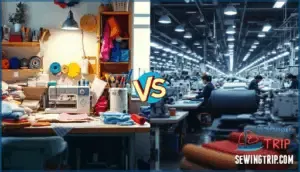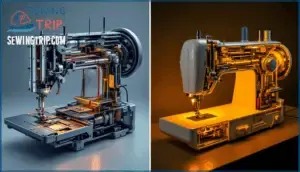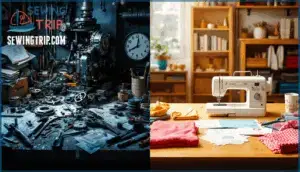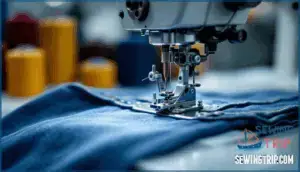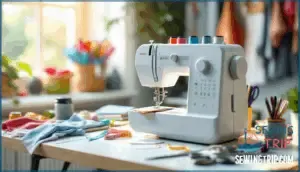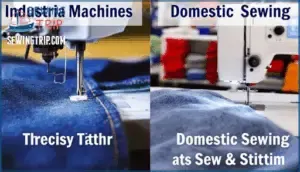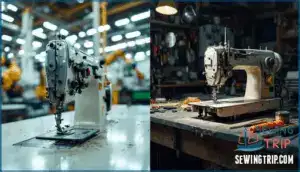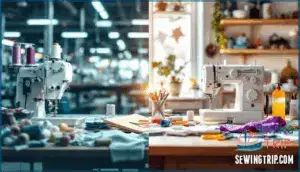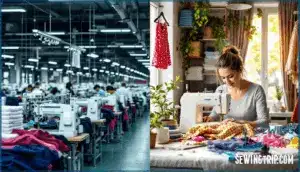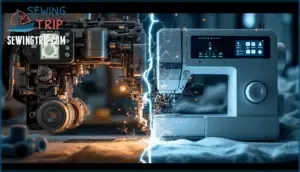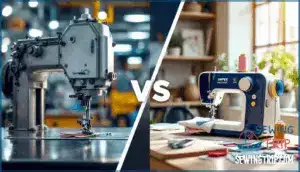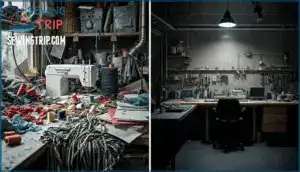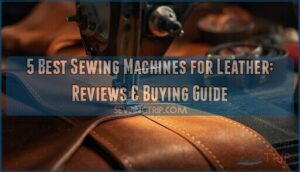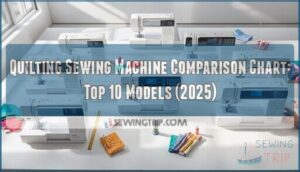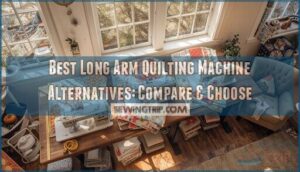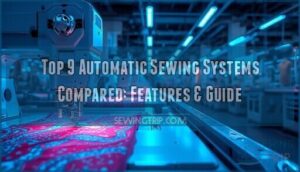This site is supported by our readers. We may earn a commission, at no cost to you, if you purchase through links.
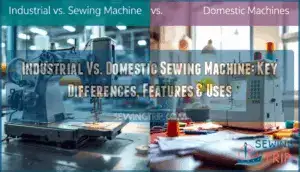
Industrial sewing machines are built like workhorses for repetitive, high-volume production, featuring sturdy metal frames and powerful motors that manage thick materials day after day. Domestic machines prioritize adaptability and user-friendliness, offering dozens of decorative stitches and lightweight portability for creative home projects.
Understanding these distinctions helps you match the right tool to your sewing needs, whether you’re launching a small production line or tackling weekend DIY projects.
Table Of Contents
- Key Takeaways
- Key Differences: Industrial Vs. Domestic Machines
- Industrial Sewing Machine Features
- Domestic Sewing Machine Features
- Stitch Quality and Sewing Speed
- Durability and Maintenance Needs
- Cost Comparison and Market Trends
- Applications: Industrial Vs. Domestic Use
- Advanced Technologies in Modern Machines
- Choosing The Right Machine for Your Needs
- Common Misconceptions and Buying Tips
- Frequently Asked Questions (FAQs)
- Conclusion
Key Takeaways
- Industrial machines stitch at speeds exceeding 5,000 stitches per minute with heavy-duty metal frames designed for repetitive, high-volume production, while domestic machines top out around 1,000 stitches per minute and prioritize versatility with lightweight, user-friendly designs for creative home projects.
- Industrial sewing machines handle thick materials like leather and upholstery through powerful motors and specialized construction, whereas domestic machines struggle with heavy fabrics and multiple layers due to limited motor strength and tension control designed for lighter textiles.
- Industrial machines require a higher upfront investment ($1,000–$7,000+) and ongoing maintenance costs but offer superior durability, longer warranties (3–5 years), and better resale value, while domestic machines ($125–$10,000) have lower operational costs but shorter lifespans and faster depreciation.
- Modern industrial machines increasingly feature automation technologies like IoT connectivity, predictive maintenance, and energy-efficient servo motors that cut power consumption by up to 70%, while only 27% of domestic machines offer comparable smart features, creating a significant technology gap between the two categories.
Key Differences: Industrial Vs. Domestic Machines
When you’re exploring sewing machines, it’s easy to overlook the real differences between industrial and domestic models. These differences shape not just what each machine can process, but who they’re built for. Here’s what sets them apart from the start.
Purpose and Typical Use Cases
Ever wonder why some sewing machines live in busy factories while others sit quietly in your laundry room? Industrial machines thrive in commercial applications—think rows managing endless jeans or heavy canvas. Domestic machines, by contrast, shine in home sewing, DIY crafts, and basics like hemming pants. Project scale, skill level, and specialized tasks all steer which machine fits your needs.
| Use Case | Industrial Machines | Domestic Machines |
|---|---|---|
| Home Sewing | Not ideal; overpowered | Perfect fit |
| Commercial Applications | Essential; made for mass production | Not suited for high volume |
| Specialized Tasks | Works with leather, upholstery | Limited to lighter fabrics |
| Project Scale | High-output runs | One-off, small-batch work |
| Skill Level | Suited for trained operators | Beginner friendly |
Design and Construction
Once you know what a sewing machine is meant to do, it’s time to look closer at how these workhorses are actually built and put together. Industrial machines lean on sturdy frame materials and tough, vibration-dampening builds. Domestic machines focus on ergonomic design and lighter component assembly, making them portable and practical for most homes.
| Feature | Industrial Machines | Domestic Machines |
|---|---|---|
| Frame Materials | Cast iron, steel | Aluminum, plastic |
| Vibration Dampening | Sophisticated systems | Basic pads |
| Component Assembly | Heavy-duty, precise | Flexible, modular |
| Machine Weight | 100+ lbs | 10–40 lbs |
User Skill Level Requirements
Choosing between these machines isn’t just about the hardware—your experience level shapes how much you’ll get out of each one. Industrial sewing machines demand more training and a steeper learning curve, making them best for experienced users or industrial use. Domestic sewing machines are built for home use, project complexity, and beginner sewers, letting skills grow comfortably over time.
| Criteria | Industrial Sewing Machine | Domestic Sewing Machine |
|---|---|---|
| Beginner Friendliness | Low | High |
| Learning Curve | Steep | Gentle |
| Required Training | Essential | Minimal |
| Skill Progression | Fast (if skilled) | Gradual |
Industrial Sewing Machine Features
Industrial sewing machines offer a different level of strength and sophistication compared to what you find at home. Their core features shape how well they manage tough jobs and big projects.
Here’s what sets them apart.
Motor Power and Performance
When you step on the pedal of an industrial sewing machine, you’re tapping into the muscle of a machine built to run all day without breaking a sweat. Industrial models have sturdy sewing machine motors, high motor torque, and refined speed control—delivering consistent power without overheating.
Vibration dampening keeps long sessions comfortable, while efficient motor types reduce power consumption, making raw horsepower practical.
Heavy-Duty Materials and Build
Think of an industrial sewing machine as the workhorse in the room, built with tough metals and solid parts to take on demanding jobs day after day. Unlike a domestic machine, every inch—frame materials, quality components, even enhanced vibration dampening—reflects a commitment to heavy-duty use.
Longevity testing and careful material sourcing keep these machines running strong for years, no shortcuts.
Automation and Smart Technologies
Ever wondered how today’s sewing machines practically think for themselves, keeping your projects on track with a touch of smart technology? Modern industrial machines now boast automatic features like IoT integration, robotic sewing, and predictive maintenance that domestic machines usually can’t match.
You’ll find:
- Smart sensors for real-time adjustments
- Automated threading and fabric manipulation
- Connectivity for remote monitoring and updates
Domestic Sewing Machine Features
Domestic sewing machines are built with your everyday needs in mind. They blend convenience, creativity, and simple controls into one compact design.
Here’s what you can usually expect from a modern home machine.
Variety of Stitches and Patterns
If you enjoy being creative with your sewing, you’ll love the range of stitches and patterns domestic machines bring to your fingertips. From the classic straight stitch to playful zig zag patterns and fancy stitches, you get options for Pattern Customization.
Want a buttonhole or a decorative touch? Specialty feet and countless Stitch Applications make complex designs accessible and exciting.
Portability and Size
You’ll notice right away how a domestic sewing machine is easy to lift, move, or tuck away—that kind of flexibility just doesn’t come with a heavy-duty industrial model. With their lighter machine weight and compact build, domestic machines fit tight spaces and small storage solutions.
If limited storage space or easy transportation matters, machine portability gives domestic machines a clear edge over industrial machines.
User-Friendly Functions
Making sewing simple isn’t just about the machine’s size—today’s domestic options are packed with features that are easy to use and take the guesswork out of getting started. Automated features like one-step threading, well-designed layouts, and simple speed controls keep the learning curve gentle.
That’s a big reason domestic machines are ideal for beginners, differing from industrial machines when it comes to usability.
Stitch Quality and Sewing Speed
When you’re deciding between industrial and domestic sewing machines, stitch quality and speed play a big part. These factors shape what you can sew and how your finished projects turn out. Here’s what you should know as you compare your options.
Precision and Consistency
When you’re working with delicate seams or thick layers, the difference between a homemade look and a professional finish often comes down to how precisely and consistently your machine can stitch. Stitch accuracy and seam quality hinge on several factors:
- Fabric control
- Tension settings
- Consistent feeding
- Design of industrial versus domestic machines
- Overall sewing machine stitch quality
Maximum Stitch Speeds
Speed is where the gap between domestic and industrial machines really shows, and it’s something you’ll feel as soon as you put your foot on the pedal.
Industrial machines hit 5,000+ SPM, powering through heavy projects. Domestic models top out near 1,000 SPM—great for detailed work.
This SPM difference impacts production, fabric types, and even skill level expectations.
Fabric and Thread Compatibility
After marveling at the speed difference, it’s just as important to look at how each machine manages everything from delicate silks to rugged canvas and chunky threads.
Industrial machines thrive on heavyweight fabric and heavy-duty thread, easily stitching thick materials or multiple layers of fabric—think upholstery material.
Domestic models, built for variety, can struggle here, requiring careful tension settings and precise needle selection to avoid material limitations.
Durability and Maintenance Needs
When you’re looking at sewing machines, durability and upkeep should be high on your list. How long a machine lasts and what it takes to keep it running can vary quite a bit.
Let’s break down what you need to know before you decide.
Lifespan and Build Quality
How long your sewing machine lasts comes down to what it’s made of and how it’s put together. Industrial sewing machines use heavy-duty build materials, so their component lifespan far outpaces most domestic machines. Domestic sewing machines, built for lighter tasks, face quicker material degradation.
Usage impact also matters—tough jobs test machine durability, but repair feasibility often keeps industrial machines in service longer.
Maintenance Frequency and Ease
Keeping your sewing machine working its best isn’t just about sturdy parts—it’s also about how simple (or stubborn) the upkeep can be. Industrial machines crave regular oiling and quick cleaning procedures, but their straightforward build keeps machine maintenance and repair complexity low.
Domestic machines, with more features packed inside, often mean trickier servicing and higher costs for machine repair.
Repair and Parts Availability
Ever wonder just how easy it is to find replacement parts or get a quick repair when your sewing machine acts up? Industrial machine parts are readily available, often making machine repair fast and predictable.
Domestic machines, on the other hand, may leave you hunting for specific spare parts. Smart buyers check warranty options, replacement guides, and maintenance tips to dodge surprise repair costs.
Cost Comparison and Market Trends
Regarding sewing machines, prices and market demand can vary a lot. It’s smart to know what to expect before you shop or upgrade.
Here’s what you should consider about costs and the trends shaping the market.
Price Ranges for Each Type
If you’ve ever wondered what sets a $150 home sewing machine apart from a $7,000 industrial powerhouse, it all comes down to purpose, power, and price. Affordable models suit casual projects; budget options ramp up to industrial machine features for heavy-duty use.
Here’s a quick sewing machine comparison:
| Type | Price Range |
|---|---|
| Domestic | $125 – $10,000 |
| Industrial | $1,000 – $7,000+ |
Market Growth and Demand
Worldwide, demand for sewing machines never really stops growing—fresh market trends show DIY projects and home startups are fueling sales of domestic machines, while industrial machines see a boost from automation in commercial sewing. Curious about the pulse? Here’s the big picture: The US market is expected to experience steady industrial growth over the next decade.
| Market | 2024 Valuation (USD) |
|---|---|
| Industrial Machines | $3.17 billion |
| Domestic Machines | $1.39 billion |
Cost of Ownership and Warranties
Beyond the sticker price, owning a sewing machine means budgeting for thread, needles, routine tune-ups, and those unexpected repairs that can catch you off guard—especially when warranties run out. Industrial machines usually carry higher operational fees but offer extended warranty options (often 3–5 years) and readily available parts, while domestic models may come with shorter coverage, increasing repair expenses down the line. Insurance coverage can offset major breakdowns for factory setups.
| Cost Factor | Industrial Machines | Domestic Machines |
|---|---|---|
| Initial Price | $1,000–$7,000+ | $125–$10,000 |
| Warranty Duration | 3–5 years (usual) | 1–2 years (usual) |
| Maintenance Costs | Higher (regular oiling) | Lower (minimal upkeep) |
| Repair Expenses | Moderate (parts available) | Variable (complex design) |
| Operational Fees | Thread, parts, service | Thread, needles, occasional service |
Compare sewing machine cost and warranty terms carefully before you commit—long-term machine warranties and costs can outweigh the sewing machine price you see upfront.
Applications: Industrial Vs. Domestic Use
Your choice between industrial and domestic machines hinges on what you’re actually making. Industrial machines power through repetitive, high-volume production in factories, while domestic models manage the varied, creative projects you’ll tackle at home.
Let’s break down where each machine shines, so you can match your equipment to your real-world applications.
Factory Production and Mass Manufacturing
In factories and mass production environments, industrial sewing machines are the workhorses that turn raw fabric into finished garments at breakneck speed, executing thousands of identical stitches hour after hour without missing a beat. These machines anchor assembly line operations, where each unit performs one specialized task.
Manufacturing efficiency depends on their reliability, and factory layout optimization guarantees smooth supply chain management across industrial-scale production processes.
| Production Aspect | Industrial Scale Impact | Key Benefit |
|---|---|---|
| Speed | 5,000+ stitches/minute | Higher output volume |
| Consistency | Identical stitch quality | Reduced defects |
| Uptime | Continuous operation | Maximized efficiency |
Home Projects and DIY Sewing
Domestic sewing machines thrive in home settings, where you’ll tackle everything from hemming jeans to crafting quilts without the need for factory-grade power or complexity. These machines manage fabric selection for garment making, follow sewing patterns for DIY decor, and even manage light home upholstery projects. Domestic machines give you the flexibility to jump between crafting ideas without committing to a single, specialized task like industrial models demand.
| Home Sewing Projects | Machine Capability |
|---|---|
| Garment alterations | Adjustable stitch length |
| Quilt piecing | Multiple decorative stitches |
| Curtain construction | Buttonhole automation |
| Costume creation | Pattern memory functions |
Specialized Sewing (Leather, Upholstery)
When your projects move from soft cotton to thick leather or furniture fabric, you’re stepping into territory where most domestic machines simply can’t deliver the muscle and precision required.
Industrial sewing machines manage heavy fabrics with ease, using specialized needles and thread types designed for demanding upholstery projects and leather sewing. Domestic machines struggle with thick materials, lacking the motor strength for consistent penetration through multiple layers without stalling or damaging components.
| Feature | Industrial Advantage |
|---|---|
| Needle penetration | Pierces leather and upholstery without hesitation |
| Thread compatibility | Manages heavy-duty bonded nylon and polyester |
| Motor power | Maintains speed through dense, layered materials |
Advanced Technologies in Modern Machines
Today’s machines aren’t just about needle and thread anymore—they’re packed with smart features that transform what’s possible. Both industrial and domestic models now use the latest innovations to boost performance, simplify workflows, and cut costs.
Let’s look at three key technological advances reshaping modern sewing.
Automation and Robotics
Automation adoption has transformed factory production processes, turning industrial machines into powerful tools for assembly lines. Robotics integration brings collaborative robots and AI sewing systems that detect fabric types, adjust patterns in real time, and monitor quality. Here’s what automation delivers:
- Automated stitching cuts labor costs by 15-30% and slashes defect rates up to 40%
- Predictive maintenance boosts equipment availability by 20%, keeping production flowing
- Robotic arms enable auto-thread cutting and programmable designs for mass customization
Domestic machine limitations are clear—only 12% feature sophisticated automation, and they lack the AI-driven adaptive control that gives industrial machine advantages their advantage in productivity. These systems also improve material handling efficiency.
IoT and Connectivity Features
Connected machines now form the backbone of modern production, bringing Remote Diagnostics and Predictive Maintenance to your factory floor. By 2025, 38% of new industrial machines include IoT connectivity, which slashes maintenance costs by 15% through real-time fault detection. These Smart Interfaces enable Cloud Integration and Data Analytics, letting you track operator performance and adjust parameters remotely.
Domestic Sewing Machine Features lag behind—only 27% offer wireless connectivity—but they’re catching up with smartphone troubleshooting apps that cut support queries by 22%.
Energy Efficiency Innovations
Servo Motors are rewriting the efficiency playbook, cutting energy use by up to 70% compared to clutch motors in industrial machines and trimming electricity costs by 25%. Intelligent Controls like VFD-controlled motors slash idle losses by over 50%, while standby functions in both industrial and domestic models minimize waste during pauses.
You’ll see Eco Materials—biodegradable components—and AI-assisted pattern tools driving Waste Reduction and zero-waste manufacturing goals.
Market Adoption is accelerating: more than 60% of new industrial sewing machines now feature energy-saving motors, with ROI delivered through lower utility bills and carbon footprints.
Choosing The Right Machine for Your Needs
Picking the right sewing machine isn’t about chasing the most expensive option—it’s about matching the tool to your actual needs. You’ll want to think through what you’re making, where you’ll work, and how much you’re willing to invest upfront and over time.
Let’s break down the key factors that’ll help you make a smart choice.
Assessing Project Requirements
Your choice of machine hinges on what you’re actually planning to sew, not just what sounds impressive on paper. If you’re tackling industrial sewing applications like mass production or heavy fabric types such as leather, you’ll need an industrial sewing machine.
For domestic sewing applications—quilting, garments, or hobby projects—a domestic sewing machine manages the project complexity just fine. Consider your skill level and project scale honestly before committing.
Space and Budget Considerations
Before you drop serious cash on a machine, take a hard look at where it’ll sit and how much room you have in your wallet. Industrial sewing machines demand significant space—their machine footprint often exceeds 400 lbs, requiring dedicated workspace and sturdy storage solutions. Domestic machines have limitations, including lighter construction but easier space optimization.
Budget allocation should account for upfront cost plus long-term costs like maintenance when weighing industrial versus domestic machines.
Long-Term Investment Factors
Think of a sewing machine as a relationship—what you gain today matters less than how it performs five years down the road. Industrial sewing machines hold stronger resale value and lower depreciation rates due to durable machine durability.
Domestic sewing machines drop in value faster but require minimal training costs.
Factor in upgrade potential, sewing machine maintenance expenses, and conduct an ROI analysis comparing sewing machine cost comparison data to choose wisely.
Common Misconceptions and Buying Tips
When shopping for a sewing machine, it’s easy to get caught in common traps or believe myths that don’t match reality. You’ll want to know what really separates industrial from heavy-duty domestic machines and how to avoid misleading claims.
Here’s what you need to watch for when making your purchase.
Identifying False Industrial Machines
Not all machines labeled "industrial" truly live up to the name, and spotting the imposters can save you from a costly mistake. Check for serial verification and build discrepancies—authentic industrial machines feature solid metal frames, not plastic components.
Verify seller reputation and watch for counterfeit parts.
Real industrial sewing machines differ drastically from domestic machines in construction, so examine weight, motor placement, and materials before purchasing.
Heavy-Duty Vs. Industrial Misunderstandings
Many sewers think "heavy-duty" and "industrial" mean the same thing, but confusing these terms can lead you straight into buyer’s remorse. Heavy-duty domestic machines manage thicker fabrics occasionally, while industrial sewing machines deliver continuous performance with specialized tasks.
Machine capabilities differ greatly—domestic models offer flexibility but a limited lifespan under constant pressure. Industrial strength means purpose-built construction for repetitive operations, not just stronger motors.
Heavy-duty domestic machines handle occasional thick fabrics, but industrial machines deliver relentless precision through construction built for repetitive, specialized tasks—not just bigger motors
User expectations should align with intended use, considering fabric limitations and repair complexity before committing.
Tips for Buying Online or In-Store
Shopping for a sewing machine without the right strategy can cost you hundreds—or even thousands—in wasted money and frustration. Start with online research comparing sewing machine features and warranty options across multiple sellers. Check seller reputation through reviews before buying sewing machines online.
For industrial sewing machines, request an inspection checklist and test the motor firsthand.
Always verify return policies—especially for sewing machine cost comparison between stores—and confirm parts availability before purchase.
Frequently Asked Questions (FAQs)
How do industrial and domestic machines handle delicate fabrics?
Like silk slipping through fingers, delicate fabrics demand finesse. Domestic machines excel here with adjustable tension control systems, specialized needle type impacts, and delicate fabric settings for light to medium-duty use.
Industrial machines, built for power over precision with stretchy fabric or sheer materials, lack gentle fabric feed mechanisms most fabric types require.
Can beginners safely operate industrial sewing machines?
Beginners can operate industrial machines, but training is essential. Industrial sewing machines run at high speeds with powerful motors, requiring strong risk awareness and material management skills.
Speed control and proper safety features help, but supervised practice matters most.
What noise levels should you expect from each type?
A shop floor running twenty industrial units can hit 85 decibel levels or higher, similar to standing beside busy traffic, so hearing protection becomes essential in factory settings. Industrial machines with clutch motors generate more vibration impact and noise than servo motor alternatives, while domestic sewing machine models usually operate at 60-70 decibels—comparable to normal conversation—making noise reduction less critical for home use.
Do industrial machines require specialized electrical outlets?
Most industrial sewing machine motors run on 220-240V single-phase or three-phase power, which isn’t standard in homes.
You’ll need specialized wiring and outlet types to meet amperage needs and safety regulations—domestic sewing machine setups won’t cut it for industrial use.
Which machine type offers better resale value?
Resale value holds up like a well-kept classic car—brand recognition and maintenance records matter most. Industrial machines from respected brands retain value better on platforms like eBay, thanks to market demand and lower depreciation factors.
Usage impact and proper servicing directly influence what buyers will pay for either domestic or industrial models.
Conclusion
Choosing between an industrial and domestic sewing machine isn’t like picking between a sports car and a minivan—it’s more like choosing between a freight train and a bicycle. Each excels in its lane.
The difference between industrial domestic sewing machine operation boils down to your production demands, budget, and skill level. If you’re stitching ten garments daily, you need industrial power. For weekend quilts and repairs, a domestic model delivers adaptability without overkill.
Match your machine to your mission, and you’ll avoid costly mistakes while achieving results that justify your investment.
- https://www.directsewingmachines.co.uk/industrial-vs-domestic-sewing-machine/
- https://www.reddit.com/r/sewhelp/comments/186u60z/home_sewing_vs_industrial_sewing_machines/
- https://merrowedge.com/pages/technical-specs
- https://www.linkedin.com/pulse/north-america-domestic-sewing-machine-market-strategic-wostf
- https://www.nebraskaquiltcompany.com/blogs/welcome-to-nqc/brother-and-singer-a-comparison-of-industrial-sewing-machines-1

